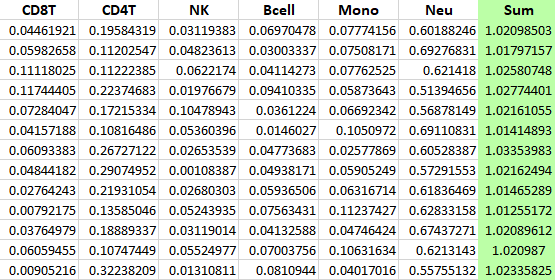Hello! I hope you are doing well.
I would like to ask if there is or are possible explanations to my issue.
Let me describe the background of my issue: I was given a dataset that included a lot of information, it was a combination of measured and predicted values. Within that dataset there were 6 different types of blood cell counts whose values were predicted using methylation data. The blood cell counts were: Bcell, CD4T, CD8T, Mono, Neu and NK. My supervisor told me that their values were calculated using the estimateCellCounts2 function from the minfi R package, using the IDOL algorithm. I am doing my dissertation, and this is the first time I am working with data that was predicted and not “physically” measured so I thought there would not be any problem until one of my professors asked me if the blood cell count proportions sum up to 1. Because I did regression analysis, my professor wanted to know if the total sum of the six blood cells counts was equal to 1 (for further analysis or correction of my methods).
My actual issue: When I sum the cell count proportions, their values are not between 0 and 1, they sum more than 1. Like this:
Individual 1 --> Bcell= 0.0446, CD4T= 0.1958, CD8T=0.0311, Mono=0.0697, Neu=0.0777, NK=0.6018
Individual 1 --> Bcell + CD4T + CD8T + Mono + Neu + NK
Individual 1 --> 0.0446 + 0.1958 + 0.0311 + 0.0697 + 0.0777 + 0.6018
Individual 1 --> 1.0207
I summed the proportions of the blood cell counts for each individual (I have a large population) and all of them were more than 1. They have variation among them, sometimes is 1.01, 1.02 or 1.03 with more decimals. We do not know the reason for this, and we are not able to re calculate this data because it was given to us like that. We do not know if the package can calculate values like those for a specific reason or if that is an error people had when estimating the values. We have the hypothesis that there is not a rounding error and perhaps the estimateCellCounts2 function from the minfi R package does that prevent a co-linearity issue.
Does anybody know why can this happen? We would really appreciate an explanation.
Thank you so much.


